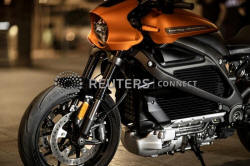Harley struggles to fire up new generation of riders with electric bike
debut
 Send a link to a friend
Send a link to a friend
 [October 07, 2019] By
Rajesh Kumar Singh [October 07, 2019] By
Rajesh Kumar Singh
CHICAGO (Reuters) - Harley-Davidson Inc <HOG.N>
is betting on electric motorcycles to attract the next generation of
younger and more environmentally conscious riders to reverse declining
U.S. sales.
But as Harley ships its first "LiveWire" bikes - priced at $29,799 - to
dealers, there is little evidence the 116-year-old brand is catching on
with new young customers.
The problem lies mostly with this "super-premium" product's price. The
bike costs nearly as much as a Tesla Model 3, and aims for a market that
does not really exist: young, "green" and affluent first-time
motorcyclists.
The sleek sport bike has been available for preorder in the United
States since January. However, the bulk of the orders are coming in from
existing and old riders, according to interviews with 40 of the 150
dealerships nationwide that are carrying the bike this year.
The dealers Reuters spoke with account for little over a quarter of
LiveWire dealerships and are spread across Wisconsin, Illinois, Indiana,
Ohio, Michigan, California, Nevada, New Jersey and New York.

Harley has for years failed to increase sales in the United States, its
top market accounting for more than half of its motorcycles sold. As its
tattooed, baby-boomer base ages, the Milwaukee-based company is finding
it challenging to woo new customers.
In 2018, Harley posted the steepest sales decline in four years in the
United States. U.S. sales are tipped to fall again this year.
(Graphic on Harley's U.S. Retail sales:
https://fingfx.thomsonreuters.com/
gfx/editorcharts/HARLEY%20DAVIDSON-ELECTRICBIKE/0H001QXBS8SB/
index.html)
The heavyweight motorcycle maker's stock price has declined by 42% in
the past five years. By comparison, the S&P 500 Index <.SPX> has gained
47%.
PRICE BARRIER
When Chief Executive Officer Matt Levatich announced LiveWire's launch
last year, his hope was the ease of riding motorcycles with no gears or
clutch would help attract young and environmentally conscious urban
riders.
In an interview with Reuters in February 2018, Levatich said the bike
would help address Harley's demographic problem.
"It is more about the next century than the last century," he said at
the time.
The preorders, thus far, have belied those hopes, according to the
dealers.
"It is appealing to a demographic that is already riding," said Gennaro
Sepe, a sales manager at a Harley dealership in Chicago. His store has
received four preorders for the bike. All of them are from existing
riders.
Harley declined to comment on LiveWire preorders.
The motorcycle maker is not the only company investing in
battery-powered transportation.
Tougher emissions rules in Europe, China and the United States are
forcing auto companies to switch to electrified models. A survey of U.S.
millennial motorcyclists, published in February by the Motorcycle
Industry Council, found 69% of the riders interested in electric
motorcycles.

Harley's dealers said they are getting inquiries from young customers,
but are struggling to translate them into sales. A key reason:
LiveWire's retail price.
"Interest is very high," said a sales manager at a New Jersey-based
dealership, who declined to be named because he was not authorized to
speak to media. "But once you get to pricing, interest is thrown out of
the window."
Over half of young college graduates in America, whom Harley is courting
with battery-powered bikes, are saddled with student loans that entail
average repayment of $200 to $300 per month.
Harley is not offering any discount or incentives to push the sales,
either, the dealers said.
In an interview with CNBC television in May, Levatich called LiveWire
"one of the best engineered products on the market" and said it was
worth its price.
Gary Jon Prough, general sales manager at a dealership in Countryside,
Illinois, said the vast majority of millennials cannot afford the bike
as LiveWire is targeted at young and affluent customers with incomes
above $100,000 a year.
[to top of second column] |

Harley-Davidson's new electric motorcycle, LiveWire, is shown in
this handout photo released by Harley-Davidson. Harley-Davidson
Motor Company/Handout via REUTERS

TESLA'S WAY
To drive up sales, Prough and other dealers expect Harley to go Tesla
Inc's <TSLA.O> way: launch more affordable battery-powered vehicles
after creating a buzz with the premium model.
Tesla's first electric car cost over $100,000, but prices came down with
subsequent models. Its Model 3 now comes with a base price of $35,000
and was instrumental in lifting its vehicle deliveries to a record level
in the latest quarter.
Traditional Harley Davidson entry-level bikes cost about $6,900.
The motorcycle maker has plans to bring out four more electrified models
in the mid-power, low-power, e-bicycles and kids' two-wheeler segments
by 2022.
But unlike Tesla, Harley does not enjoy the true first mover's
advantage.
California-based Zero Motorcycles is already selling electric bikes in
the United States with retail prices ranging from $8,500 to $21,000. Its
top-end bike - SR/F - is similar to LiveWire, but costs nearly $9,000
less.
Still, Bob Clark, a dealer for Zero's bikes in Chicago, says he has not
yet sold one SR/F to riders under the age of 35. All three electric
bikes he sold to young riders this year were in the $10,000 price range.
"Young riders are environmentally conscious, but are also very
price-sensitive," Clark said.
It is not just pricing. LiveWire's limited range is also hampering its
sales.

The bike can travel 146 miles (235 km) in the city or 95 miles in
combined city and highway riding per charge. An ordinary household
outlet can provide an overnight charge, while Level 3 direct current
fast chargers stationed at Harley dealers will fully charge the bike in
60 minutes.
This renders LiveWire less effective for longer-distance rides, limiting
its appeal among rural riders who prefer touring bikes.
Seven Harley dealerships told Reuters they have not even bothered
ordering the bike, which would require investing in a Level 3 charging
station and training staff.
An Ohio-based dealer, who had initially signed up for LiveWire, said he
pulled out at the last minute as he was not sure of the bike's demand in
his area.
DELAYED ARRIVAL
A delay in LiveWire's arrival in stores has left the dealers in the
Midwest and the East Coast with hardly a month to aggressively push the
bike before the snow season sets in. Winter generally means a lull for
motorcycle sales.
When dealers began taking preorders, the delivery was expected in
August, but was later shifted to September. On Sept. 30, the dealers
Reuters spoke with were still waiting for the first bike.
In a Twitter post on Oct. 2, Harley said the bikes are starting to
arrive at authorized dealers. The tweet also carried a picture of the
first LiveWire that was "rolled off the line" at its York, Pennsylvania,
facility in late September.
With the demand rather limited, the dealers said, Harley has decided to
keep the supplies tight in order to protect the bike's brand value and
prevent any price-discounting pressure. The dealers said they are all
expecting to receive less than 10 LiveWires this year.
James Hardiman, an analyst at Wedbush Securities, reckons Harley would
sell between 400 and 1,600 LiveWires in the first year. That is not even
1% of the 228,051 bikes it sold worldwide last year.
"This is going to be largely a rounding error certainly this year and
even next," Hardiman said.
(Reporting by Rajesh Kumar Singh in Chicago; Editing by Caroline
Stauffer and Matthew Lewis)
[© 2019 Thomson Reuters. All rights
reserved.] Copyright 2019 Reuters. All rights reserved. This material may not be published,
broadcast, rewritten or redistributed.
Thompson Reuters is solely responsible for this content.
 |